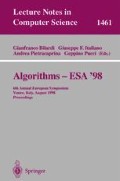Abstract
The Matrix-To-Line problem is that of, given an n × n symmetric matrix D, finding an arrangement of n points on the real line such that the so obtained distances agree as well as possible with the by D specified distances, w.r.t. the max-norm. The Matrix-To-Line problem has previously been shown to be NP-complete [11]. We show that it can be approximated within 2, but not within 4/3 unless P=NP. We also show tight bounds under a stronger assumption. We show that the Matrix-To-Line problem cannot be approximated within 2 − δ unless 3-colorable graphs can be colored with ⌈4/δ⌉ colors in polynomial time. Currently, the best polynomial time algorithm colors a 3-colorable graph with Õ(n 3/14) colors [4].
We apply our Matrix-To-Line algorithm to a problem in computational biology, namely, the Radiation Hybrid (RH) problem, i.e., the algorithmic part of a physical mapping method called RH mapping. This gives us the first algorithm with a guaranteed convergence for the general RH problem.
Access this chapter
Tax calculation will be finalised at checkout
Purchases are for personal use only
Preview
Unable to display preview. Download preview PDF.
References
Richa Agarwala, Vineet Bafna, Martin Farach, Babu Narayanan, Mike Paterson, and Mikkel Thorup. On the approximability of numerical taxonomy (fitting distances by tree metrics). In Proceedings of the Seventh Annual ACM-SIAM Symposium on Discrete Algorithms, pages 365–372, 1996.
Amir Ben-Dor and Benny Chor. On constructing radiation hybrid maps. In Proceedings of the First International Conference on Computational Molecular Biology, pages 17–26, 1997.
D. Timothy Bishop and Gillian P. Crockford. Comparison of radiation hybrid mapping and linkage mapping. Cytogenet Cell Genet, 59:93–95, 1992.
Avrim Blum and David Karger. An Õ (n 3/14)-coloring algorithm for 3-colorable graphs. Information Processing Letters, 61(1):49–53, 1997.
Andreas W. M. Dress and Timothy F. Havel. Bound smoothing under chirality constraints. SIAM J. Disc. Math., 4:535–549, 1991.
Martin Farach and Sampath Kannan. Efficient algorithms for inverting evolution. In Proceedings of the Twenty-Eighth Annual ACM Symposium on Theory of Computing, pages 230–236, 1996.
Martin Farach, Sampath Kannan, and Tandy Warnow. A robust model for finding optimal evolutionary trees (extended abstract). In Proceedings of the Twenty-Fifth Annual ACM Symposium on Theory of Computing, pages 137–145, 1993.
Wassily Hoeffding. Probability inequalities for sums of bounded random variables. Journal of the American Statistical Association, 58(301):13–30, March 1963.
Sanjeev Khanna, Nathan Linial, and Shmuel Safra. On the hardness of approximating the chromatic number. In ISTCS93, 1993.
Kenneth Lange, Michael Boehnke, David R. Cox, and Kathryn L. Lunetta. Statistical methods for polyploid radiation hybrid mapping. Genome Research, 5:136–150, 1995.
James B. Saxe. Embeddability of graphs in k-space is strongly NP-hard. In 17th Allerton Conference in Communication, Control, and Computing, pages 480–489, 1979.
Thomas J. Schaefer. The complexity of satisfiability problems. In Conference Record of the Tenth Annual ACM Symposium on Theory of Computing, pages 216–226, 1978.
Donna Slonim, Leonid Kruglyak, Lincoln Stein, and Eric Lander. Building human genome maps with radiation hybrids. In Proceedings of the First International Conference on Computational Molecular Biology, pages 277–286, 1997.
Author information
Authors and Affiliations
Editor information
Editors and Affiliations
Rights and permissions
Copyright information
© 1998 Springer-Verlag Berlin Heidelberg
About this paper
Cite this paper
Håstad, J., Ivansson, L., Lagergren, J. (1998). Fitting Points on the Real Line and Its Application to RH Mapping. In: Bilardi, G., Italiano, G.F., Pietracaprina, A., Pucci, G. (eds) Algorithms — ESA’ 98. ESA 1998. Lecture Notes in Computer Science, vol 1461. Springer, Berlin, Heidelberg. https://doi.org/10.1007/3-540-68530-8_39
Download citation
DOI: https://doi.org/10.1007/3-540-68530-8_39
Published:
Publisher Name: Springer, Berlin, Heidelberg
Print ISBN: 978-3-540-64848-2
Online ISBN: 978-3-540-68530-2
eBook Packages: Springer Book Archive

